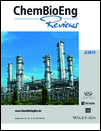Centrifugal Separation with Emphasis on the Rotational Particle Separator
Corresponding Author
Erik van Kemenade
Eindhoven University of Technology, PO box 513, 5600 MB Eindhoven, The Netherlands.
Eindhoven University of Technology, PO box 513, 5600 MB Eindhoven, The Netherlands.Search for more papers by this authorBert Brouwers
Eindhoven University of Technology, PO box 513, 5600 MB Eindhoven, The Netherlands.
Romico Hold A.V.V., Burg. Cortenstraat 24, 5662 GV Maastricht, The Netherlands.
Search for more papers by this authorRob van Benthum
Eindhoven University of Technology, PO box 513, 5600 MB Eindhoven, The Netherlands.
Search for more papers by this authorCorresponding Author
Erik van Kemenade
Eindhoven University of Technology, PO box 513, 5600 MB Eindhoven, The Netherlands.
Eindhoven University of Technology, PO box 513, 5600 MB Eindhoven, The Netherlands.Search for more papers by this authorBert Brouwers
Eindhoven University of Technology, PO box 513, 5600 MB Eindhoven, The Netherlands.
Romico Hold A.V.V., Burg. Cortenstraat 24, 5662 GV Maastricht, The Netherlands.
Search for more papers by this authorRob van Benthum
Eindhoven University of Technology, PO box 513, 5600 MB Eindhoven, The Netherlands.
Search for more papers by this authorAbstract
A review is given of separation methods based on centrifugation. Attention is focused on separation of mixtures of gases and droplets. More particularly we consider: the method of gas centrifuges or ultra-centrifuges to separate gases of different molecular weight, and centrifugal separators to separate droplets from gases. Elementary physical principles are used to formulate basic equations. From here on, rules are derived for separation performance, energy consumption and size of the installations. Status of technology of each of the methods is illustrated by presenting actual cases of application.
References
- 1 GPSA Engineering Data Book, Gas Processors Suppliers Association, Tulsa, OK 2012.
- 2 CRC Handbook of Chemistry and Physics, 89th ed., CRC Press, Boca Raton, FL 2008.
- 3
A. Kohl, R. Nielsen, Gas Purification, Gulf Publications, Houston, TX 1997.
10.1016/B978-088415220-0/50009-4 Google Scholar
- 4 J. F. A. Delbeke, G. Eklund, B. P. M. Van Esch, G. Janssens-Maenhout, W. Janssens, Energy 2010, 35 (8), 3123–3130. DOI: 10.1016/j.energy.2010.02.039
- 5 M. Golombok, K. Bil, Ind. Eng. Chem. Res. 2005, 60 (16), 4397–4407.
- 6 R. J. E. van Wissen, M. Golombok, J. J. H. Brouwers, Chem. Eng. Sci. 2005, 53, 374–380.
- 7 W. C. Hinds, Aerosol Technology, John Wiley and Sons, New York 1982.
- 8 Gas/Liquid Separation Technology, Sulzer Chemtech, Winterthur 2012, http://www.sulzer.com/en/-/media/Documents/ProductsAndServices/Separation_Technology/Mist_Eliminators/Brochures/Gas_Liquid_Separation_Technology.pdf (accessed June 26, 2014).
- 9 J. J. H. Brouwers, Nucl. Technol. 1978, 39, 311–322.
- 10 F. Aston, E. Lindemann, Phil. Mag. 1919, 6 (37), 523.
- 11 K. P. Cohen, The Theory of Isotope Separation as Applied to the Large-Scale Production of U-235, McGraw-Hill, New York 1951.
- 12 N. A. Fuchs, The Mechanics of Aerosols, Dover Publications, New York 1964.
- 13 J. J. H. Brouwers, H. P. van Kemenade, J. P. Kroes, Filtration 2012, 12, 49–60.
- 14 R. B. Bird, W. E. Stewart, E. N. Lightfoot, Transport Phenomena, John Wiley and Sons, Hoboken, NJ 2007.
- 15 R. J. E. van Wissen, J. J. H. Brouwers, M. Golombok, AIChE J. 2007, 53, 374–380. DOI: 10.1002/aic.11074
- 16 W. Barth, Brennst. Waerme Kraft 1956, 8, 640–643.
- 17 G. P. Willems, Ph.D. Thesis, Eindhoven University of Technology 2009. http://alexandria.tue.nl/extra2/200911885.pdf
- 18 A. C. Hoffmann, L. E. Stein, Gas Cyclones and Swirl Tubes: Principles, Design And Operation, Springer, Berlin 2008.
- 19 E. van Kemenade, E. Mondt, T. Hendriks, P. Verbeek, Chem. Eng. Technol. 2003, 26 (11), 1176–1183. DOI: 10.1002/ceat.200301803
- 20 R. Buruma, B. Brouwers, E. van Kemenade, Chem. Eng. Technol. 2012, 35 (9), 1576–1582. DOI: 10.1002/ceat.201200188
- 21 J. P. Kroes, Ph.D. Thesis, Eindhoven University of Technology 2012. http://purl.tue.nl/706335649322755
- 22 J. J. H. Brouwers, Exp. Therm. Fluid Sci. 2002, 26 (2–4), 325–334. DOI: 10.1016/S0894-1777(02)00144-9
- 23 J. J. H. Brouwers, Appl. Sc. Res. 1995, 55 (2), 95–105. DOI: 10.1007/BF00868465
- 24 B. P. M. Van Esch, J. G. M. Kuerten, J. Turb., 2008, 9 (4), 1–17. DOI: 10.1080/14685240701847837
- 25 J. G. M. Kuerten, B. P. M. van Esch, H. P. van Kemenade, J. J. H. Brouwers, Int. J. Heat Fluid Flow 2007, 28 (4), 630–637. DOI: 10.1016/j.ijheatfluidflow.2007.03.003
- 26 E. Mondt, E. van Kemenade, R. Schook, Chem. Eng. Technol. 2006, 29 (3), 375–383. DOI: 10.1002/ceat.200500395
- 27 E. Brunazzi, A. Paglianti, A. Talamelli, AIChE J. 2003, 49 (1), 41–51. DOI: 10.1002/aic.690490106
- 28 H. Houghton, W. Radford, T. Am. Chem. Eng. 1939, 35, 427–433.
- 29 J. J. H. Brouwers, Chem. Eng. Technol. 1996, 19 (1), 1–10. DOI: 10.1002/ceat.270190102
- 30 S. Jacobsson, T. Austrheim, A. C. Hoffmann, Ind. Eng. Chem. Res. 2006, 45 (19), 6525–6530. DOI: 10.1021/ie051200s
- 31 G. P. Willems, J. P. Kroes, M. Golombok, B. P. M. van Esch, H. P. van Kemenade, J. J. H. Brouwers, J. Fluids Eng. 2010, 132 (3), 031301. DOI: 10.1115/1.4001008
- 32 E. Mondt, H. P. van Kemenade, J. J. H. Brouwers, E. A. Bramer, Proc. of the 3rd Int. Symp. on Two Phase Flow Modelling and Experimentation, (Eds: G. P. Celata) Edizioni ETS, Pisa 2004, 1845.
- 33 E. Mondt, B. Brouwers, E. van Kemenade, Chem. Eng. Technol. 2007, 30 (5), 593–600. DOI: 10.1002/ceat.200700005
- 34 G. P. Willems, B. P. M. van Esch, J. J. H. Brouwers, M. Golombok, Chem. Eng. Sci. 2008, 63 (13), 3358–3365. DOI: 10.1016/j.ces.2008.04.009
- 35 E. Mondt, Ph.D. Thesis, Eindhoven University of Technology 2005. http://alexandria.tue.nl/extra2/200513466.pdf
- 36 R. J. van Benthum, Ph.D. Thesis, Eindhoven University of Technology 2014. http://repository.tue.nl/762323
- 37 G. P. Willems, M. Golombok, G. Tesselaar, J. J. H. Brouwers, AIChE J. 2010, 56 (1), 150–159.
- 38 G. D. Bansal, M. Golombok, J. J. H. Brouwers, Ind. Eng. Chem. Res. 2011, 50 (5), 3011–3020.




